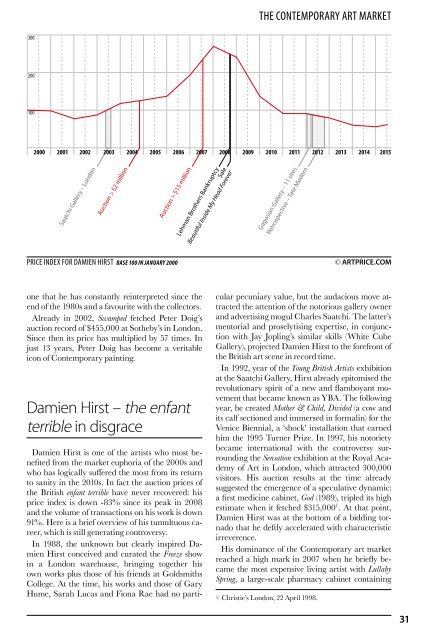THE contemporary
mMjqAT
mMjqAT
Create successful ePaper yourself
Turn your PDF publications into a flip-book with our unique Google optimized e-Paper software.
The <strong>contemporary</strong> art market<br />
300<br />
200<br />
100<br />
2000 2001 2002 2003 2004 2005 2006 2007 2008 2009 2010 2011 2012 2013 2014 2015<br />
Saatchi Gallery – London<br />
Auction > $2 million<br />
Auction > $15 million<br />
Lehman Brothers Bankruptcy<br />
Sale<br />
Beautiful Inside My Head Forever<br />
Gagosian Gallery – 11 sites<br />
Retrospective – Tate Modern<br />
Price Index for Damien Hirst Base 100 in January 2000<br />
© ARTPRICE.COM<br />
one that he has constantly reinterpreted since the<br />
end of the 1980s and a favourite with the collectors.<br />
Already in 2002, Swamped fetched Peter Doig’s<br />
auction record of $455,000 at Sotheby’s in London.<br />
Since then its price has multiplied by 57 times. In<br />
just 13 years, Peter Doig has become a veritable<br />
icon of Contemporary painting.<br />
Damien Hirst – the enfant<br />
terrible in disgrace<br />
Damien Hirst is one of the artists who most benefited<br />
from the market euphoria of the 2000s and<br />
who has logically suffered the most from its return<br />
to sanity in the 2010s. In fact the auction prices of<br />
the British enfant terrible have never recovered: his<br />
price index is down -83% since its peak in 2008<br />
and the volume of transactions on his work is down<br />
91%. Here is a brief overview of his tumultuous career,<br />
which is still generating controversy.<br />
In 1988, the unknown but clearly inspired Damien<br />
Hirst conceived and curated the Freeze show<br />
in a London warehouse, bringing together his<br />
own works plus those of his friends at Goldsmiths<br />
College. At the time, his works and those of Gary<br />
Hume, Sarah Lucas and Fiona Rae had no particular<br />
pecuniary value, but the audacious move attracted<br />
the attention of the notorious gallery owner<br />
and advertising mogul Charles Saatchi. The latter’s<br />
mentorial and proselytising expertise, in conjunction<br />
with Jay Jopling’s similar skills (White Cube<br />
Gallery), projected Damien Hirst to the forefront of<br />
the British art scene in record time.<br />
In 1992, year of the Young British Artists exhibition<br />
at the Saatchi Gallery, Hirst already epitomised the<br />
revolutionary spirit of a new and flamboyant movement<br />
that became known as YBA. The following<br />
year, he created Mother & Child, Divided (a cow and<br />
its calf sectioned and immersed in formalin) for the<br />
Venice Biennial, a ‘shock’ installation that earned<br />
him the 1995 Turner Prize. In 1997, his notoriety<br />
became international with the controversy surrounding<br />
the Sensation exhibition at the Royal Academy<br />
of Art in London, which attracted 300,000<br />
visitors. His auction results at the time already<br />
suggested the emergence of a speculative dynamic:<br />
a first medicine cabinet, God (1989), tripled its high<br />
estimate when it fetched $315,000 1 . At that point,<br />
Damien Hirst was at the bottom of a bidding tornado<br />
that he deftly accelerated with characteristic<br />
irreverence.<br />
His dominance of the Contemporary art market<br />
reached a high mark in 2007 when he briefly became<br />
the most expensive living artist with Lullaby<br />
Spring, a large-scale pharmacy cabinet containing<br />
1) Christie’s London, 22 April 1998.<br />
31


